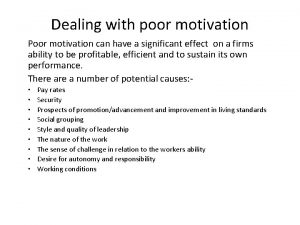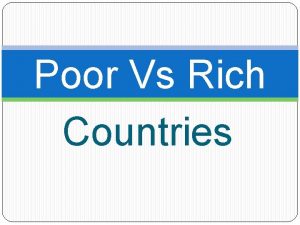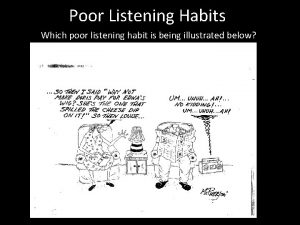Analysis of Competition Dealing with the Competition Poor



























- Slides: 27

Analysis of Competition Dealing with the Competition Poor firms ignore their competitors; average firms copy their competitors; winning firms lead their competitors. Philip Kotler

Why to analyze competitors? • Knowing the competitors is critical to effective marketing planning • A company must constantly compare its products, prices, places and promotion with those of its competitors • In this way, it can identify areas of competitive advantage and disadvantage • The company can launch more precise attacks on its competitors as well as prepare stronger defenses against attacks • Sometimes competitor can become a partner

BASIC QUESTIONS • . 1 Who are our competitors? +who are not our competitors yet but they can be? (why they are not competing now(? • 2. What are their objectives? • 3. What are their strategies? „ 4 Ps“ • . 4 What are their strengths and weaknesses? Analyze competitors’ ability to: – – – • Conceive and design new products Produce the product or deliver the service Market their products Finance Manage . 5 What are their reaction patterns?

Understanding the competitors Size, Growth & Profitability Strengths and Weaknesses Image and Positioning Competitor Actions Exit Barriers Objectives and Commitment Current and Past Strategies Organization and Culture Cost Structure 4 Figure 3. 3

Michael Porter model of 5 competitive forces Five Forces Determining Segment Structural Attractiveness Threat of: 1. intense segment rivalry 2. new entrants 3. substitute products 4. buyers’ bargaining power 5. suppliers’ bargaining power

Rivalry Between Established Competitors The extent to which industry profitability is depressed by aggressive price competition depends upon: • Concentration (number and size distribution of firms) • Diversity of competitors (differences in goals, cost structure, etc. ) • Product differentiation • Excess capacity and exit barriers • Cost conditions – Extent of scale economies – Ratio of fixed to variable costs

Identifying competitors • Market concept of competition (WIDER VIEW) Looking at companies that satisfy the same customer need Gives broader set of actual and potential competitors and stimulates more long-run strategic marketing planning • Industry concept of competition Looking at companies that make the „same“ product – Industry = set of sellers and degree of differentiation • Pure monopoly • Oligopoly – Pure oligopoly – Differentiated oligopoly • Monopolistic competition • Pure competition

• Pure monopoly • Only one firm offers an undifferentiated product or service in an area – Unregulated – Regulated • Example: Most utility companies Differentiated oligopoly • A few firms produce partially differentiated items • Differentiation is by key attributes • Premium price may be charged • Example: Luxury autos • Pure oligopoly • • • A few firms produce essentially identical commodities and little differentiation exists Lower costs are the key to higher profits Example: oil • Monopolistic Competition • Many firms differentiate items in whole or part • Appropriate market segmentation is key to success • Example: beer, restaurants

• Pure competition • Many competitors offer the same product • Price is the same due to lack of differentiation • Example: farmers selling milk, coal, wood…

Identifying and analyzing competitors – Entry, Mobility, Exit Barriers • Entry barriers • Mobility barriers • Exit barriers – Cost Structure – Degree of Vertical Integration • Vertical integration – Degree of Globalization • Key characteristics of the competition must be identified: – Strategies – Objectives – Strengths and Weaknesses • Effect a firm’s competitive position in the target market – Reaction Patterns

Other ways of Identifying Competitors – Supply-based approaches • Classify competitors based on objective attributes. – Demand-based approaches • Classify competitors based on customer attitudes and behaviors. – The Product-Industry Hierarchy identifies four levels of competition.

Demand-Based Methods – from the customer’s perspective. • Product form competition: narrowest form, includes products of the same product type. • Product class/category competition: products with similar features that provide the same basic function. • Generic competition: products that fulfill same basic need. • Budget competition: products that compete for the same discretionary budget dollars. 4 – LEVEL COMPETITION

other view: levels of competition Brand Competition Industry Competition Other companies offering a similar product and services to the same customer at similar prices All companies making the same product or class of products Form Competition All companies manufacturing products that supply the same service Generic Competition All companies competing for the same customer´s money

• Four-level model of competition implies different tasks for each competitive level: – Product form competition: aim marketing activities at direct competitors. – Product class/category competition: convince customers that your product form is best in the category. – Generic competition: convince consumers of the superiority of your product category’s ability to satisfy needs over other categories. – Budget competition: same challenge as with generic competition.

Identifying key success factors Pre-requisites for success How does the firm survive competition What do customers want? Analysis of demand Analysis of competition • What drives competition? • Who are our customers? • What are the main dimensions of competition? • What do they want? • How intense is competition? • How can we obtain a superior competitive position? KEY SUCCESS FACTORS

Analyzing competitors • Strengths and Weaknesses – – – Dominant Strong Favorable Tenable „sustainable“ Weak Nonviable Customer’s Ratings of Competitors on Key Success Factors Customer Awareness Product Quality Product Availability Technical Assistance Selling Staff Competitor A E E P P G Competitor B G G E Competitor C F P G F F Note: E = excellent, G = good, F = fair, P = poor.

Analyzing competitors Three ways or variables to monitor when analyzing competitors: • Share of market • Share of mind The percentage of customers who named the competitor in responding to the statement “Name the first company that comes to mind in this industry” • Share of heart The percentage of customers who named the competitor in responding to the statement “Name the company from whom you would prefer to buy the product” http: //www. youtube. com/watch? v=n. Urv. PMQq. ZZQ KFC vs Mc. Donalds´ • http: //www. vidarena. com/coca-cola-vspepsivideo_599_1_vid. EM o 6 o 0 Bt. FG 8. html#vid eo 1

Assessing Competitive Positions: Strategic Groups • • • A Strategic Group consists of those rival firms with similar competitive approaches and positions in an industry A Strategic Group displays different competitive positions that rival firms occupy Organizations in the same strategic group have one or more competitive characteristics in common – – – Sell in the same price/quality range Cover same geographic areas Be vertically integrated to same degree Emphasize same types of distribution channels Offer buyers similar services Use identical technological approaches

Strategic groups Price Upscale Chains Diners/Family Style Fast Food Selection • Groups of firms that pursue similar strategies with similar resources

Balancing customer and competitor orientations Competitor-centered company Customer-centered company • It develops a fighter orientation: • It is in a better position to being on constant alert, identify new opportunities watching for weaknesses in its and set a strategy course competitors’ and its own that makes long-run sense position • It can decide which customer • It determines its moves based on groups and emerging needs its competitors’ moves; does not are the most important to move towards its own goal serve, given its resources and objectives

Designing Competitive Strategies MARKET LEADER • Expanding the total market • Defending market share • Expanding market share MARKET CHALLENGER • First define the strategic goals and opponent(s) • Choose general attack strategy • Choose specific attack strategy

MARKET LEADER Expanding the total market: – Targeting Product to New Users • Market-penetration strategy • New-market strategy • Geographical-expansion strategy – Promoting New Uses of Product – Encouraging Greater Product Use • • • q. NEW USERS q. NEW USES q. MORE USAGE Defending market share Position defense Flank (side) defense Preemptive (preventive) defense Counteroffensive defense Mobile defense Contraction defense

Expanding Market Share • Develop and add more new products to the line • Increase the product quality relative to competitors • Increase the marketing expenditures faster the rate of market growth to achieve share gains • Avoid price cut, but offer other values to the customers

Defending Market Share. 2 Flank defense Attacker . 3 Preemptive defense . 1 Position defense . 4 Counteroffensive defense Defender )Leader( . 5 Mobile defense . 6 Contraction defense

MARKET CHALLENGER General attack atrategies: – – Frontal attacks match competition Flank attacks serve unmet market needs or underserved areas Encirclement “blitzes” opponent Bypassing opponent and attacking easier markets is also an option Specific attack strategies include: • • Price-discount Lower-price goods Prestige goods Improved services Product proliferation Product innovation Distribution innovation Manufacturing cost reduction

Strategies for Market Challenger Attacker )Challenger( . 2 Flank attack . 4 Bypass attack . 1 Frontal attack . 5 Guerrilla attack . 3 Encirclement attack Defender

MARKET FOLLOWER • Imitation may be more profitable than innovation • Four broad strategies: – – Counterfeiter Cloner Imitator Adapter MARKET NICHER • Niche specialties: – – – End-user Vertical-level Customer-size Specific customer Geographic Product/product line Product feature Job-shop Quality-price Service Channel
 Dealing with competition marketing management
Dealing with competition marketing management Dealing with competition marketing management
Dealing with competition marketing management Lump sum subsidy monopoly
Lump sum subsidy monopoly Monopoly vs monopolistic competition
Monopoly vs monopolistic competition Pure competition vs monopolistic competition venn diagram
Pure competition vs monopolistic competition venn diagram Competition refers to
Competition refers to Branch of linguistics dealing with meaning
Branch of linguistics dealing with meaning Abiotic components
Abiotic components Section 2 dealing with other nations
Section 2 dealing with other nations Call center stress
Call center stress Genre of speculative fiction
Genre of speculative fiction Chapter 5 lesson 1 dealing with anxiety and depression
Chapter 5 lesson 1 dealing with anxiety and depression Chapter 5 lesson 1 dealing with anxiety and depression
Chapter 5 lesson 1 dealing with anxiety and depression Unit 1 dealing with incoming calls
Unit 1 dealing with incoming calls Dealing with anger in the bible
Dealing with anger in the bible Dealing successfully with difficult changes in your life
Dealing successfully with difficult changes in your life Lexicological unit
Lexicological unit Play with unhappy ending
Play with unhappy ending Dealing with unstructured data
Dealing with unstructured data Aegisoft
Aegisoft Dealing with unstructured data
Dealing with unstructured data The branch of zoology dealing with insects
The branch of zoology dealing with insects The branch of zoology dealing with insects
The branch of zoology dealing with insects Dealing with challenging patients
Dealing with challenging patients Dealing successfully with difficult changes in your life
Dealing successfully with difficult changes in your life Dealing with unstructured data
Dealing with unstructured data Alan linning
Alan linning When dealing with a complaint it is vital to remember that
When dealing with a complaint it is vital to remember that



















































